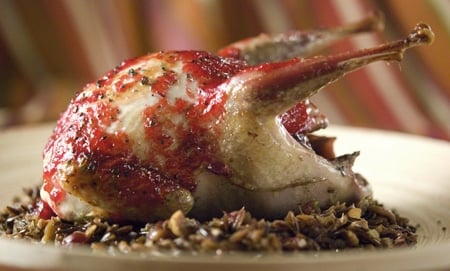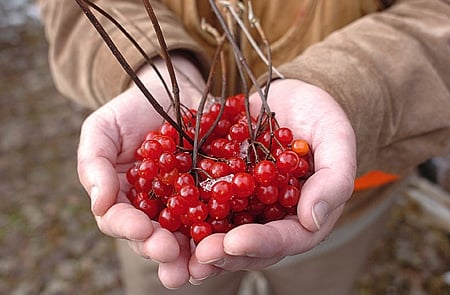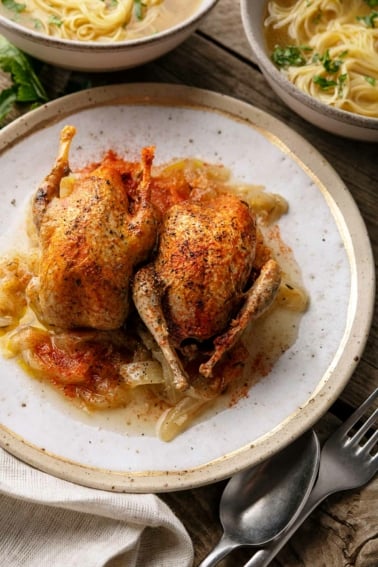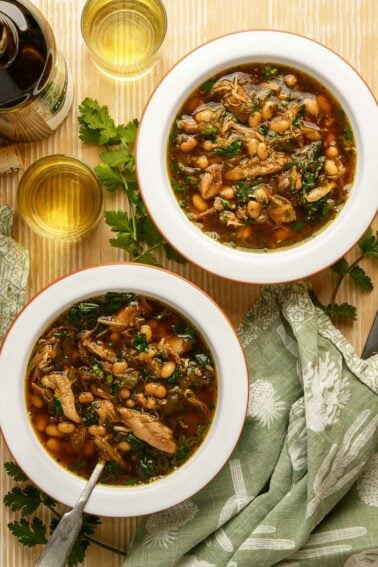Roast Grouse and Minnesota’s Glories
November 06, 2009 | Updated October 29, 2020
As an Amazon Associate I earn from qualifying purchases.

I’ve met many here in California who think that all good things can be had in our Golden State, where the magic of fresh and local and seasonal cooking is strongest. They’re wrong.
Just five years after Alice Waters opened Chez Panisse, a similar restaurant opened in chilly Madison, Wisconsin, called L’Etoile. Just as Waters’ mantra was (and is) fresh-local-seasonal, so it was with Odessa Piper. I first ate there as a graduate student in 1992 and was, frankly, shocked at such good food so far from my home in New York. Piper has retired, but L’Etoile lives on and is still a giant of Midwest restaurants.
I mention this little history lesson to make this point: It requires far more skill and imagination to be seasonal and local in a place like Madison, where winter temperatures can drop to -30°F, than it is in Berkeley, where it rarely, if ever, actually freezes.
With that skill and imagination, the Upper Midwest becomes a treasure trove of magical ingredients that are all-but unobtainable if you are a California locavore: Wild rice, hickory and butternut, walleye, yellow perch and wild currants to name a few. As a hunter and forager, I can add others, none more important than woodcock and ruffed grouse.

These are high bush cranberries (not actually cranberries), a member of the viburnum family. They taste like cranberries, however, and are softer and sweeter after a frost — you can see the snow on the ones in my hands. Very tart, the berries need sugar to balance them out. But they make a great glaze for the grouse.
I also saw tons of mushrooms while walking in the woods, and noticed that most of the grouse we flushed had been eating catkins off hazel bushes. My friend Chris, who I was hunting with, said these bushes will set little hazel nuts the size of your pinkie finger, but the bears usually get them first; we saw a lot of bear shit around, too.
Mushrooms… Hazel nuts… Grouse… I decided to invent a Minnesota North Woods pilaf to go with roast grouse. Many of my decisions about this meal (and other wild meals) I made using a slightly grisly method: As I cleaned and plucked the grouse, I opened up their crops and looked inside.
A bird’s crop is a sac at the base of its throat that stores whatever it eats until the muscular gizzard can grind it up enough for the bird to use it as nutrition. These grouse all had viburnum berries, hazel catkins, clover and strawberry leaves in their crops. Ideas for later.
Grouse are not corn-eating pheasants. I might serve pheasants with polenta, but I would never do that with a ruffed grouse. They are woodland birds and need to be treated that way. The pilaf, I decided, would look like the duff on the forest floor — only tasty.
As for the grouse themselves, plucking them is difficult. Most hunters skin them, as it is far easier, but I couldn’t bear to lose that skin, which adds flavor and protects the meat from drying out. If you have grouse and want to pluck them, follow my instructions for plucking pheasants, only dip your grouse for 20 seconds at a time, not 30. If you do it right — be patient! — you should get a lovely plucked grouse.
The woodland pilaf — wild rice, toasted hazelnuts, shallots, maitake mushrooms, cranberries, rosemary, shallots and butter — needed a good 50 minutes to come together. It wasn’t the most colorful dish I’ve ever made, but it fit: It really did look like the forest floor. It all came together nicely.
How can I describe the flavor of a roast grouse? The first words that spring to mind are “funky” or “gamey,” but in a good way. There is an aroma to grouse that I’ve never encountered before, and, just like roast pigeon, the legs and thighs have the best flavor by far. The breasts remained fairly tender, and tasted closer to “chicken,” although the grousey aroma and flavor was still there.
The woodland pilaf brought it all together. Earthy, dark and welcoming, it was quite the bed for the grouse to rest on. The hazelnuts had softened and became meaty, and the crushed maitake mushrooms melded with the wild rice to create a texture and flavor that’s tough to describe; al dente pasta comes closest. The balsam notes from rosemary and the tart craisins tied it to the grouse above. And the butter gave it a proper North Woods richness.
No matter where you live, flavors are all around you; all you need to do is put them together.
Simple Roast Grouse
Ingredients
- 2 grouse, plucked and whole
- 3 tablespoons unsalted butter
- 1 lemon
- Salt and pepper
Instructions
- Preheat oven to 450°F. Remove grouse from the fridge and pat dry. Let stand at room temperature for 30 minutes while the oven is heating. Halve the lemon and stick each half into the grouse. Smear butter all over the grouse, including a small knob in the cavity and under the neck where the crop once was. Use more than you think you need, at least a tablespoon per grouse, preferably two.
- Place the birds in a roasting pan or cast-iron frying pan and roast for 15 minutes. Turn the heat down to 350°F and turn the grouse on one side. Baste it thoroughly with the melted butter in the pan. Roast for another 10 minutes. Repeat by turning the grouse on the other side. Be sure to baste again. Roast for 10 more minutes.
- Remove the birds from the oven and let rest on a cutting board, covered in foil, for 10 minutes.
Notes
Nutrition
Nutrition information is automatically calculated, so should only be used as an approximation.






Sarah. No, a pre-salt will not be as good as a brine. You need time to get the salt deep into the meat. Good luck with the birds — are they whole with skin? If not, let me know, as I am planning a recipe with skinned grouse soon.
My dad is bringing me 7 (!) grouse when they come over for Thanksgiving. Would a pre-salt work just as well as a brine for these birds? I’ve never had them before, and I don’t want to mess up one of my only chances to taste them! Thank you.
What a great web-site, I’m looking at this at about 7am and it’s already making me hungry, again, just after breakfast.
The upper mid-west can be bleak in the fall & winter and the only way to survive it is to hunt, fish and cross-country ski. Northern Cali can also be pretty darn gray, too, with all that Tule fog along The 5-interstate, but world class duck hunting, though.
I’ve never seen a grouse look better on the table. A truly inspired dinner. Thank you!
I remarked during this dinner that I think duck is the only bird whose breast meat is equal to or better than its leg meat.
That said, this was pretty damn good breast meat.
Thanks, all, for the nice comments on the photos.
Good description on the difference between the leg and the breast. I’ve always thought the breast tasted like that of a farm raised phesant while the leg was definately better and reminded me of a very large, tender squirell.
Can’t wait to try the sauce some of our wineberries next year!
That certainly looks delicious. Time for breakfast. Perhaps a new venison sausage recipe may be in the works? Keep it up.
Nick: I cannot vouch for their flavor, as I’ve yet to eat them — thus the regrets. But from my reading they are definitely not harmful. They are said to be very tough, but that young ones are edible.
I can, however, vouch for their fina aroma — like a piney mushroomy smell. I wanted to try them out to see if they’d be worth picking — I was thinking they’d be a little like a piney chicken-of-the-woods mushroom…
Hank — you’ve referred now twice to your regrets for not picking the Birch polypore mushrooms. We have tons around our house and everything I’ve read has said they are inedible. Do you have evidence to the contrary?
Hank – brilliant idea about looking in the crop for inspiration. Simple. Whatever they’ve been feeding on will flavour the meat anyway, you are just finishing what the bird started.
As a consumer of lots of wild meat, I’m grateful for the tip. Thanks.
Hank, I just want to thank you for posting that wonderful recipe for the sexiest mushroom soup ever (lo those many weeks ago). I finally got to make it tonight, with shiitakes, and considering the fact that half my audience doesn’t like mushrooms but everyone loved the soup, I count it as a success! Thanks again. Also, the grouse looks tasty.
I’m impressed. I never thought I’d want to visit Minnesota (despite all the time I’ve spent in New England, I don’t like cold weather), but this post is making me rethink my position!
Looks great, glad you had success in the Northwoods. I grew up in Minnesota (just south of Duluth), and spent many a fall hunting grouse, although for some reason everybody called them partridge even though we knew they weren’t.
Your point is also well taken-there is bounty everywhere, but some places it takes a bit more work!
Fishguy: Shoot the bird first. The berries don’t move as fast…
El: Guinea hens, eh? You know you’re right — they are sorta close. Definitely closer than chicken. And equally prone to dryness.
How did I get my birds home? I froze them solid and put them in my checked luggage. Easy-Peasy.
Carolina Rig: LMAO. One of the better stories I’ve heard in a while. But you shoulda made poison ivy gelee! 😉
Diana, Pete and Laura: Thanks a heap!
Wow. I’m super jealous of your adventure and meal. This sounds like something I’d love to do!
Everything looks amazing.
Laura
Good lord, Hank. That first image is so savory I don’t even need to read the post. You should be arrested by the salivary police.
What a lovely post. Thank you!
I love the deep sense of place in this meal. While I would never live anywhere but California, I certainly don’t believe that the world needs to eat the same way that we do.
All birds cooked at home should look like that last pic!
The first bird crop I ever investigated came from my first turkey. It’s crop was stuffed with moth’s, grasshopper’s, clover, and poison ivy. Looking back I guess I could have developed a meal around clover honey glazed roasted turkey, w/ choclate covered insects as dessert. But what to do with the poison ivy??? Needless to say the turkey got it’s revenge as I broke out in a rash the following day.
Lovely post, and great sentiment: not all can be gotten in the Golden State, and indeed much is best outside of it. But then, I am biased.
The only domestic bird that approximates the taste of grouse is the guinea, in my mind. Good tips on brining these gamey creatures: it is a bit of a pickle, timing it right and yet coming out with the breast not overdry. That pairing sounds delectable too: local tastes marrying local goodies.
But a question, Hank: how in the world did you get those birds home with you? Did you freeze them first, or put them in a carry-on?
Hank, you are slowly turning me into a forager. I just hope I don’t forget to shoot the bird while looking for highbush cranberries. Great article, especially like the last pic!